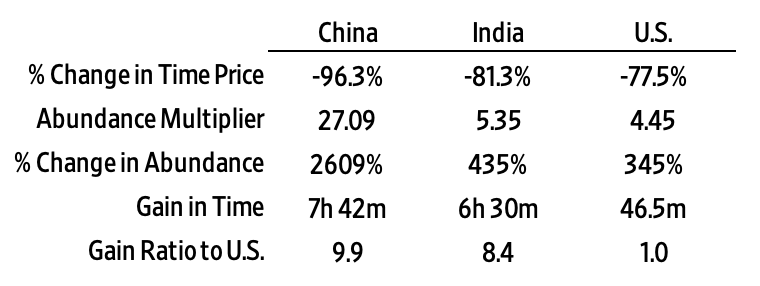Time Equality is Increasing Dramatically
We all have exactly 24 hours a day, so why not measure our standard of living in time, instead of money?
Jordan Peterson’s Rule No. 4 says you should “Compare Yourself to Who You Were Yesterday, Not Who Someone Else is Today.” Since we all get exactly 24 hours a day, and no one can really buy time, (otherwise rich people would never die) it might also be better to compare differences in how we spend our time. Instead of comparing differences in money income between people, we should compare differences in how we spend our time today versus yesterday.
According to the World Bank, in 1960 nominal GDP per capita in China was $89.50. By 2021 it had increased by 13,929 percent to $12,556. Over this same time period, nominal GDP in India increased by 2,671 percent from $82.19 to $2,277.43, and in the U.S. it increased from $3,007 to $69,287, or by 2,204 percent.
Chinese GDP per capita grew six times faster than the U.S. The ratio of China to U.S. GDP per capita in 1960 was 33.6. By 2021 it had fallen to 5.52. The ratio of India to U.S. GDP per capita in 1960 was 36.6. By 2021 it had fallen to 30.4. China is making pretty good progress, but there is still a significant gap in GDP per capita.
Perhaps a better way to compare inequality is with time. Let’s start with the time to earn the money to buy a basket of basic food. The World Bank tracks the nominal price of rice, wheat, and maize (corn). These three commodities represent the most common basic calories around the planet. An index of the nominal prices indicates an increase of 418 percent from a base value of 1 in 1960 to 5.18 in 2021.
Comparing the price of this three-food index to GDP per capita in China over this period indicates a 96.3 percent decrease in the time price of this food basket. A person in China in 1960 working eight hours to earn the money to buy their food would only need to spend around 18 minutes in 2021. For the time it took to buy one basket in 1960, they would get 27 baskets in 2021. They gained 7 hours and 42 minutes a day to devote to other activities.
The index fell by 81.3 percent in India. A person in India in 1960 working eight hours to earn the money to buy their food would only need to spend around 90 minutes in 2021. For the time it took to buy one basket in 1960, they would get 5.35 baskets in 2021. They gained 6 hours and 30 minutes a day.
In contrast, using the three-food price as an index, a person in the U.S. in 1960 working one hour a day to earn their food would only need to spend around 13.5 minutes in 2021. Their time price had dropped by 77.5 percent. For the time it took to buy one basket in 1960, they would get 4.45 baskets in 2021. Americans gained 46.5 minutes a day to devote to other activities.
From this perspective, the difference, or time gap, in 1960 was 420 minutes between Chinese and Indians to Americans. By 2021, it dropped to 76.5 for Indians and 4.5 minutes for Chinese.
For every one minute Americans gained in time, Chinese gained almost ten and Indians gained 8.4. Time inequality has dramatically compressed.
As new knowledge and innovation drops the time price of basic food items, people have much more time to devote to other activities including leisure and learning. And when people have the time to get on learning curves and discover new knowledge, we all benefit.
You can learn more about these economic facts and ideas in our new book, Superabundance, available at Amazon. Jordan Peterson calls it a “profoundly optimistic book.”
Gale Pooley is a Senior Fellow at the Discovery Institute and a board member at Human Progress.






